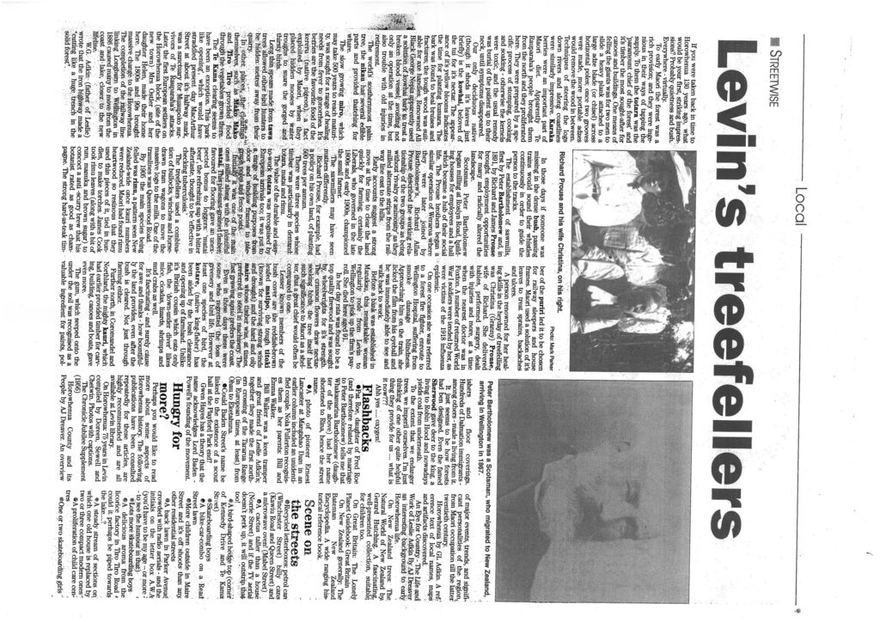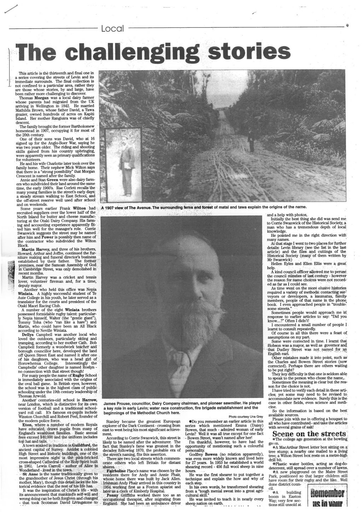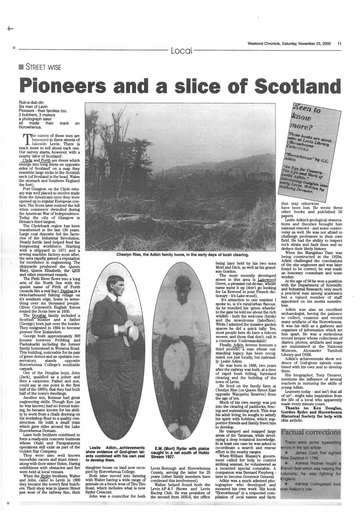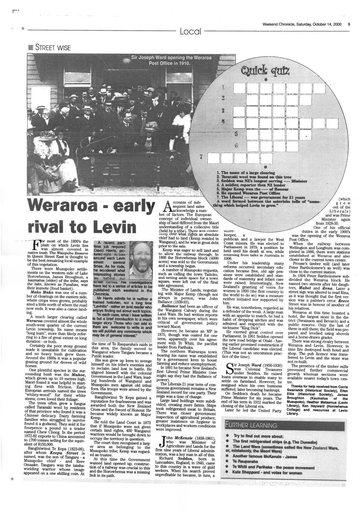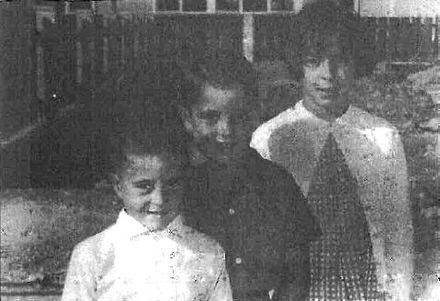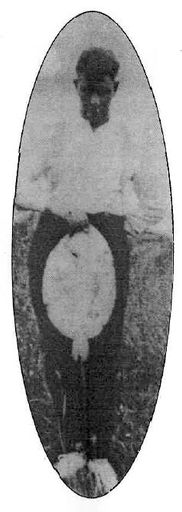Levin's treefellers
- Description
If you were taken back in time to Horowhenua 130 years ago, what Would be your first, striking impressions? Probably quietness and bush. Everywhere - virtually.
To early Maori the forest was a rich provision; and they were ingenious in their ways of tapping the supply: To them the totara was the 'paramount chief of the forest' and it's timber the most sought-after for canoes and buildings. One means of felling the giants was for two men to slide a heavy plank attached to a large adze blade (or chisel) across horizontal poles; once two grooves were made, more portable adzes would remove the wood in between. Techniques of steering the logs down. rivers and along coastlines were similarly impressive. Karaka berries were an important part of Maori diet. Apparently Te Rauparaha's people brought them from the north and they proliferated here. They were prepared by a specific process of stomping, cooking and soaking - otherwise the kernels were toxic, and the usual remedy was burial of the patient up to their neck, until symptoms disappeared.
Our only deciduous native (though it sheds it's leaves just briefly) is the kowhai, beloved of the tui for it's nectar. The appearance of it's yellow blooms indicates the time for planting kumara. The bark was found to heal bruises and
fractures; the tough wood was suitable for axe handles: ..Renowned All. Black George Nepia apparently used a solution of kowliai bark to treat a broken. blood vessel; avoiding not only an operation at the time, but also trouble with old injuries in retirement.
The world's southernmost palm
tree' the nikau has several edible parts and provided thatching for whare.
The slow growing miro which . may take 500 years to reach maturity, was sought for a range of healing needs from fever to gonorrhea. It's berries are the 'favourite food of the kereru (native .pigeon), a fact exploited by Maori, when they placed. hidden nooses by 'Water troughs to snare the gorged and thirsty birds.
Long thin spears .made from tawa trees allowed other bird hunters to be hidden metres away from their quarry.
In other places, the clearings themselves, such as Mako Mako and Tiro Tiro provided food through the vegetables grown there.The Te Kama clearing seems to have been an exception. This 'park like opening', which would have straddled present day MacArthur Street at about its halfway mark, was a sanctuary for Muaupoko survivors of Te Rauparaha's attacks. Later, the first European settlers on the Horowhenua block, (site of the new town), Mrs Ostler and her daughter Helen, made their home here. The 1800s and 90s brought massive change, to the Horowhenua. The completion of the Railway line linking Lortgburn to Wellington in 1886 caused many to move from the coast and , lake, closer to the new lifeline.
W.G.- Adkin (father of Leslie) wrote that the iron highway made a "cutting like a huge, trench in the solid forest".
In those days if someone was missing in the dense bush, passing trains would sound their whistles continuously in order to guide the person to the tracks.
The establishrrient of sawmills, first by Peter Bartholomew and, in 1891, by Richard and James Prouse brought employment opportunities for many and radically altered the landscape.
Scotsman Peter Bartholomew began milling at Roslyn Road, building houses for employees and a hall which became a hub of their social life. The Prouse brothers began a similar operation of Weraroa where they were later joined by Bartholomew's, Richard Allan Prouse described the working relationship of the two groups as being without 'rivalry or 'aninimosity' as they milled alternate strips from the rail-way line east to the hills.
Early accounts suggest a strong move at the time to clear the land quickly for farming; certainly the Liberals, who governed in the late 1800s and early 1900s, championed the small farmer. The sawmillers may have seen matters differently. Richard Prouse, for example, had , a policy on his own land, of planting 500 trees per annum. There were three species whose , timber was particularly in demand: totara, matai and rimu. The value of the durable and easy-to-work totara was recognised by European arnvals too; it was put to a range of building purposes from door andwindow frames, to fence posts. Initially it wa sone of the'main ones miiled along with the plentiful Matai. This pleasant-grained timber favoured for flooring gave an unexpected bonus to loggers:- `matai beer', the refreshing sap with a bitter aftertaste, thought to be 'effective in checking tuberculosis.' The treefellers used a combination of bullocks wvinches and horse-drawn tram wagons to move the massive logs to the mills. One of the tramlines was Queenwood Read. By 1905 the main species being felled was rimu, a pattern seen New Zealand-wide once kauri numbers were reduced. Maori had found rimu heartwood so resinous that they used thin pieces of it, tied in bundles, to make torches. James Cook took rimu leaves (along with a bit of rum, manuka and brown sugar) to concoct a anti -scurvy brew that his botanist rated as good as champagne.Photo: Mark Parker ber of the
The strong hard-as-teak timber of the puriri led it to be chosen for railway sleepers and house frames. Maori used a solution of it's leaves to treat sprains, backaches and ulcers. A person renowned for her healing skills in the heyday of treefelling was Christina (Granny) Prouse, wife of Richard. She delivered babies, performed surgery, dealt with injuries and more, at a time when the nearest doctor was in Foxton. A number of returned World War I soldiers were tended by her, as were victims of the 1918 influenza epidemic. On one occasion she was referred to a forest fire fighter, enroute to Wellington hospital, suffering from smoke damage blindness. Approaching him on the train, she licked the film from his eyeball and he as immediately able to see and walk back to Work. Before -bank was established in Manakau, this remarkable woman regularly rode from Levin to Wellingtonto:pick up the firm's pay-roll. She died here,aged 91. In her day rata. was found to be a top quality firewood and was sought by wheelwrights for it's strength. The crimson flowersdraw necatr seeking birds; the tree itself had suchsignificance to Maori as a shelter, that a great chief would often be compared to one.
Lesser known membersof the bush cover are the reddish-brown leafed Matipo, the tough titoki (known for surviving strong 'winds and drought) and the hard - and oily Maire whose timber was , at times, preferred, to steel inmachinery. The fast growing ngaio prefers the coast.
Even in those days there were some who regretted the loss of greenery and bird life. However at least one species of bird, the kotare, (native kingfisher) has been aided by the bush clearance and opening up of farmland. Unlike it's British cousin which eats only fish, the 'down-under diver' likes mice, cicadas, lizards, shrimps and mud crabs as well. ,It's fascinating - and surely cause for awe and thanks - how bountifully the land provides, even after the bush is cleared. Not just through farming either. Further north, in Coromandel and Northland, the mighty kauri, which had earlier provided timber for carving, building, canoes and boats, gave even more. The gum, which seeped onto the under the soil was recognised as a valuable ingredient -for paints, polishers and floor coverings. Hundreds of Dalmation immigrants - among others - made a living from it. It just seems to be how forests had been designed. Even the famed Sherwood gave deer to the king, a living to Robin Hood and nowadays yields coal from underneath. To the extent that we endanger trees, we imperil ourselves. I'm just thinking of one other quite helpful thing they provide for us .... what is it now??? Ahh yes oxygen!
Flashbacks
•Pat Roe, daughter of Fred Roe (and therefore related by marriage to Peter Bartholomew) tells me that Whakamarina Bartholomew (daughter of the above) had her name shortened to Rina, hence the street name. A photo of pioneer Ernest Lancaster at Mangahao Dam in an earlier column included an unidentified couple. Nola Fullerton recognises them as her parents: Bill and Emma Walker. Bill Walker was a keen tramper and great friend of Leslie Adkin's; together they made the first northern crossing of the Tarartia Range. (in European times, at least) from Ohau to Eketahuna. Could Baden Street's name be linked to the existence of a scout hall at the Playford Park end? Gwen Hayes has a theory that the name acknowledges Lord Baden - Powell's founding of the movement.
Hungry for more?Perhaps you Would like to read more about some aspects of Horowhenua, history. The following publications have been consulted repeatedly for these articles, are highly recommended and are all available at Levin library.
- On Horowhenua: 75 years in Levin compiled by Doreen, Sewell and Chetwin. Photos with captions.
- The Chronicle Jubilee Supplement (1956)
- Horowhenua County and its People by AJ Dreaver. An overview of major events, trends, and significant personalities of the region, from Maori occupation till the latter twentieth century
- Horowhenua by GL Adkin. A reference text of local names, maps and artifacts discovered.
- An Eye for Country - The Life and Work of Leslie Adlkin By AJ Dreaver all interesting 'background to early Horowhenua life.
- On New Zealand trees: The Natural World of New Zealand by Gerard Hutching. A fascinating, well-presented collection, suitable for children too.
- On Great Britain: The Loney Planet Guidebook: Great Britain
- On New Zealand generally: The Bateman New Zealand Encyclopedia A wide ranging his-torical reference book.
- who migrated to New Zealand,
Scene on the streets
- Recycled letterboxes: petrol can (Winchester Street) billy cans (Kavviu Road and Queen Street) and a microwave oven! (Mabel Street).
- A cactus taller than a house (Norrie Street) and if the TV aerial doesn't perk up, it will outstrip that too!
- A bird-shaped hedge top (corner of Kennedy Drive and Te Kama Street).
- Skateboarding boys.
- A bike-car-combo on a Read Street lawn.
- More children outside in Maire Street and it's off shoots than any other residential streets.
- A back lawn in Parker Avenue, crowded:with radio aerials - and the initials, on the letter box A.W.A (you'd have to be my age or more- - to see the humour in that).
- Lots more Skateboarding boys.
- A delicious aroma from the licorice factory in Tiro Tiro Road could it perhaps be piped towards the lake....?
- A steady stream of sections on 'which one old house is replaced by two or three compact modern ones.
- A proliferation of child care care centres.
- One or two skateboarding girls.
photo: Peter Bartholomew was a Scotsman, arriving in Wellington in 1867.
Identification
- Date
- circa 2000
Taxonomy
- Community Tags

